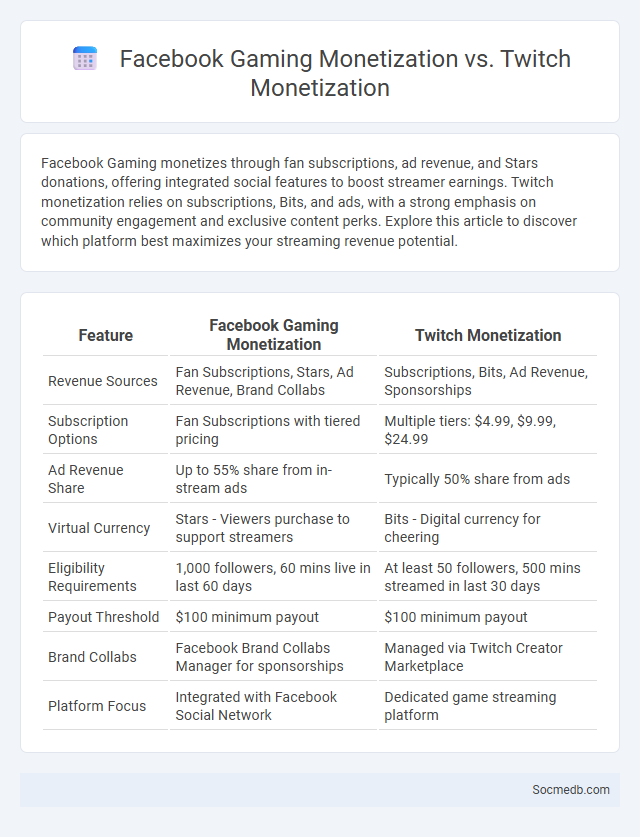
Photo illustration: Facebook Gaming Monetization vs Twitch Monetization
Facebook Gaming monetizes through fan subscriptions, ad revenue, and Stars donations, offering integrated social features to boost streamer earnings. Twitch monetization relies on subscriptions, Bits, and ads, with a strong emphasis on community engagement and exclusive content perks. Explore this article to discover which platform best maximizes your streaming revenue potential.
Table of Comparison
| Feature | Facebook Gaming Monetization | Twitch Monetization |
|---|---|---|
| Revenue Sources | Fan Subscriptions, Stars, Ad Revenue, Brand Collabs | Subscriptions, Bits, Ad Revenue, Sponsorships |
| Subscription Options | Fan Subscriptions with tiered pricing | Multiple tiers: $4.99, $9.99, $24.99 |
| Ad Revenue Share | Up to 55% share from in-stream ads | Typically 50% share from ads |
| Virtual Currency | Stars - Viewers purchase to support streamers | Bits - Digital currency for cheering |
| Eligibility Requirements | 1,000 followers, 60 mins live in last 60 days | At least 50 followers, 500 mins streamed in last 30 days |
| Payout Threshold | $100 minimum payout | $100 minimum payout |
| Brand Collabs | Facebook Brand Collabs Manager for sponsorships | Managed via Twitch Creator Marketplace |
| Platform Focus | Integrated with Facebook Social Network | Dedicated game streaming platform |
Overview of Facebook Gaming, Twitch, and General Monetization
Facebook Gaming offers a robust platform for streamers with integrated social features and direct fan interactions, leveraging Facebook's extensive user base for audience growth. Twitch remains the leading live streaming service with comprehensive monetization options such as subscriptions, Bits, and ad revenue, fostering a strong community-oriented ecosystem. General monetization strategies across these platforms include brand sponsorships, donations, affiliate marketing, and exclusive content through subscription tiers, maximizing revenue potential for content creators.
Platform Requirements for Monetization
Social media platforms require creators to meet specific criteria for monetization, including minimum follower counts, consistent content engagement, and adherence to community guidelines. Platforms like YouTube typically mandate 1,000 subscribers and 4,000 watch hours within 12 months for eligibility, while Instagram demands a certain number of followers and engagement rates. Compliance with platform-specific rules ensures access to revenue streams such as ad revenue, sponsored content, and fan donations.
Revenue Streams: Ads, Subscriptions, and Donations
Social media platforms generate significant revenue through targeted advertising by leveraging user data to deliver personalized ads that maximize engagement and conversion rates. Subscription models offer users ad-free experiences or exclusive content, providing a steady income stream alongside traditional ad revenues. Donations, often facilitated by features like live-stream tipping or crowdfunding, create a direct financial support mechanism between users and content creators on social media.
Payout Structures and Thresholds
Social media platforms typically implement payout structures based on content engagement metrics such as views, clicks, and ad impressions, with varying thresholds that creators must reach before earning revenue. Common payout thresholds range from $50 to $100, ensuring that creators accumulate a minimum balance before withdrawals are processed. These payout models incentivize high-quality content production while maintaining platform compliance and fraud prevention.
Audience Engagement and Growth Opportunities
Social media platforms offer powerful tools for audience engagement through interactive content, live videos, and personalized communication, fostering stronger connections and loyalty. Leveraging analytics and targeted advertising enables brands to identify growth opportunities by reaching niche markets and optimizing content strategies. Consistent engagement combined with data-driven insights drives sustainable audience expansion and enhances overall brand visibility.
Creator Support Tools and Analytics
Creator Support Tools and Analytics empower you to maximize engagement by providing in-depth insights into audience behavior and content performance. Advanced metrics allow you to track real-time growth, identify high-performing posts, and optimize posting schedules for increased reach. Leveraging these tools enhances content strategy, driving better monetization and community building on social media platforms.
Policy Compliance and Content Restrictions
Social media platforms enforce strict policy compliance and content restrictions to protect users and maintain a safe online environment. Your posts must adhere to guidelines that prohibit hate speech, misinformation, and explicit content to avoid suspension or removal. Understanding these regulations ensures your content remains visible and your account secure.
Brand Partnerships and Sponsorship Potential
Brand partnerships and sponsorship potential on social media platforms offer businesses unparalleled opportunities to amplify their reach and engage targeted audiences effectively. By leveraging data-driven insights and influencer collaborations, your brand can create authentic connections that drive conversion and enhance brand loyalty. Maximizing these strategic alliances results in measurable growth and a stronger market presence across digital channels.
Platform Fees and Revenue Splits
Social media platforms typically implement platform fees and revenue splits to monetize content created by users, taking a percentage of earnings generated through ads, subscriptions, or digital goods. Revenue splits vary across major platforms, with Facebook and Instagram commonly taking 30%, while TikTok recently adjusted its creator fund policies to optimize payout structures. Understanding these fee structures is crucial for influencers and content creators to maximize income and strategize platform engagement.
Choosing the Right Platform for Your Monetization Goals
Selecting the right social media platform depends on your target audience's demographics and the type of content you plan to monetize, such as video, images, or written posts. Platforms like Instagram and TikTok excel for visual content and influencer-based monetization, while YouTube offers strong ad revenue opportunities through long-form videos. Understanding the unique monetization features and user engagement patterns on each platform empowers you to maximize your earnings effectively.
 socmedb.com
socmedb.com